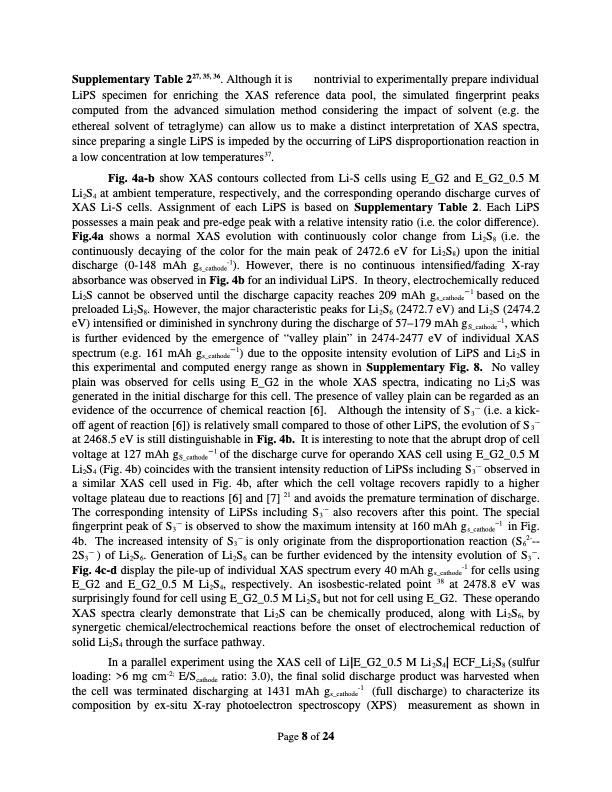
PDF Publication Title:
Text from PDF Page: 008
Supplementary Table 227, 35, 36. Although it is nontrivial to experimentally prepare individual LiPS specimen for enriching the XAS reference data pool, the simulated fingerprint peaks computed from the advanced simulation method considering the impact of solvent (e.g. the ethereal solvent of tetraglyme) can allow us to make a distinct interpretation of XAS spectra, since preparing a single LiPS is impeded by the occurring of LiPS disproportionation reaction in a low concentration at low temperatures37. Fig. 4a-b show XAS contours collected from Li-S cells using E_G2 and E_G2_0.5 M Li2S4 at ambient temperature, respectively, and the corresponding operando discharge curves of XAS Li-S cells. Assignment of each LiPS is based on Supplementary Table 2. Each LiPS possesses a main peak and pre-edge peak with a relative intensity ratio (i.e. the color difference). Fig.4a shows a normal XAS evolution with continuously color change from Li2S8 (i.e. the continuously decaying of the color for the main peak of 2472.6 eV for Li2S8) upon the initial discharge (0-148 mAh gs_cathode-1). However, there is no continuous intensified/fading X-ray absorbance was observed in Fig. 4b for an individual LiPS. In theory, electrochemically reduced Li2S cannot be observed until the discharge capacity reaches 209 mAh gs_cathode−1 based on the preloaded Li2S8. However, the major characteristic peaks for Li2S6 (2472.7 eV) and Li2S (2474.2 eV) intensified or diminished in synchrony during the discharge of 57–179 mAh gS_cathode−1, which is further evidenced by the emergence of “valley plain” in 2474-2477 eV of individual XAS spectrum (e.g. 161 mAh gs_cathode−1) due to the opposite intensity evolution of LiPS and Li2S in this experimental and computed energy range as shown in Supplementary Fig. 8. No valley plain was observed for cells using E_G2 in the whole XAS spectra, indicating no Li2S was generated in the initial discharge for this cell. The presence of valley plain can be regarded as an evidence of the occurrence of chemical reaction [6]. Although the intensity of S3∙− (i.e. a kick- off agent of reaction [6]) is relatively small compared to those of other LiPS, the evolution of S3∙− at 2468.5 eV is still distinguishable in Fig. 4b. It is interesting to note that the abrupt drop of cell voltage at 127 mAh gS_cathode−1 of the discharge curve for operando XAS cell using E_G2_0.5 M Li2S4 (Fig. 4b) coincides with the transient intensity reduction of LiPSs including S3∙− observed in a similar XAS cell used in Fig. 4b, after which the cell voltage recovers rapidly to a higher voltage plateau due to reactions [6] and [7] 21 and avoids the premature termination of discharge. The corresponding intensity of LiPSs including S3∙− also recovers after this point. The special fingerprint peak of S3∙− is observed to show the maximum intensity at 160 mAh gs_cathode−1 in Fig. 4b. The increased intensity of S3∙− is only originate from the disproportionation reaction (S62--- 2S3∙− ) of Li2S6. Generation of Li2S6 can be further evidenced by the intensity evolution of S3∙−. Fig. 4c-d display the pile-up of individual XAS spectrum every 40 mAh gs_cathode-1 for cells using E_G2 and E_G2_0.5 M Li2S4, respectively. An isosbestic-related point 38 at 2478.8 eV was surprisingly found for cell using E_G2_0.5 M Li2S4 but not for cell using E_G2. These operando XAS spectra clearly demonstrate that Li2S can be chemically produced, along with Li2S6, by synergetic chemical/electrochemical reactions before the onset of electrochemical reduction of solid Li2S4 through the surface pathway. In a parallel experiment using the XAS cell of LiǀE_G2_0.5 M Li2S4ǀ ECF_Li2S8 (sulfur loading: >6 mg cm-2; E/Scathode ratio: 3.0), the final solid discharge product was harvested when the cell was terminated discharging at 1431 mAh gs_cathode-1 (full discharge) to characterize its composition by ex-situ X-ray photoelectron spectroscopy (XPS) measurement as shown in Page 8 of 24PDF Image | A lithium-sulfur battery with a solution-mediated pathway

PDF Search Title:
A lithium-sulfur battery with a solution-mediated pathwayOriginal File Name Searched:
qt9bt5f7wt_noSplash_4e336387563ecb2106bd171b37448483.pdfDIY PDF Search: Google It | Yahoo | Bing
Sulfur Deposition on Carbon Nanofibers using Supercritical CO2 Sulfur Deposition on Carbon Nanofibers using Supercritical CO2. Gamma sulfur also known as mother of pearl sulfur and nacreous sulfur... More Info
CO2 Organic Rankine Cycle Experimenter Platform The supercritical CO2 phase change system is both a heat pump and organic rankine cycle which can be used for those purposes and as a supercritical extractor for advanced subcritical and supercritical extraction technology. Uses include producing nanoparticles, precious metal CO2 extraction, lithium battery recycling, and other applications... More Info
| CONTACT TEL: 608-238-6001 Email: greg@infinityturbine.com | RSS | AMP |